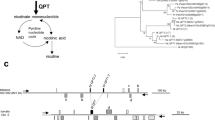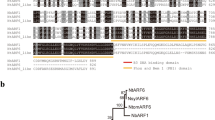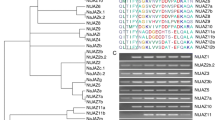Abstract
Plants in the Nicotiana genus produce nicotine and related pyridine alkaloids as a part of their chemical defense against insect herbivores. These alkaloids are formed by condensation of a derivative of nicotinic acid, but the enzyme(s) involved in the final condensation step remains elusive. In Nicotiana tabacum, an orphan reductase A622 and its close homolog A622L are coordinately expressed in the root, upregulated by methyl jasmonate treatment, and controlled by the NIC regulatory loci specific to the biosynthesis of tobacco alkaloids. Conditional suppression of A622 and A622L by RNA interference inhibited cell growth, severely decreased the formation of all tobacco alkaloids, and concomitantly induced an accumulation of nicotinic acid β-N-glucoside, a probable detoxification metabolite of nicotinic acid, in both hairy roots and methyl jasmonate-elicited cultured cells of tobacco. N-methylpyrrolinium cation, a precursor of the pyrrolidine moiety of nicotine, also accumulated in the A622(L)-knockdown hairy roots. We propose that the tobacco A622-like reductases of the PIP family are involved in either the formation of a nicotinic acid-derived precursor or the final condensation reaction of tobacco alkaloids.








Similar content being viewed by others
References
Akashi T, Koshimizu S, Aoki T, Ayabe S (2006) Identification of cDNAs encoding pterocarpan reductase involved in isoflavan phytoalexin biosynthesis in Lotus japonicus by EST mining. FEBS Lett 580:5666–5670. doi:10.1016/j.febslet.2006.09.016
An G (1985) High efficiency transformation of cultured tobacco cells. Plant Physiol 79:568–570
Cane KA, Mayer M, Lidgett AJ, Michael AJ, Hamill JD (2005) Molecular analysis of alkaloid metabolism in AABB v. aabb genotype Nicotiana tabacum in response to wounding of aerial tissues and methyl jasmonate treatment of cultured roots. Funct Plant Biol 32:305–320. doi:10.1071/FP04008
Chu A, Dikova A, Davin LB, Bedgar DL, Lewis NG (1993) Stereospecificity of (+)-pinoresinol and (+)-lariciresinol reductases from Forsythia intermedia. J Biol Chem 268:27026–27033
Clarkson JJ, Lim KY, Kovarik A, Chase MW, Knapp S, Leitch AR (2005) Long-term genome diploidization in allopolyploid Nicotiana section Repandae (Solanaceae). New Phytol 168:241–252. doi:10.1111/j.1469-8137.2005.01480.x
Dawson RF, Christman DR, D’Adamo A, Solt ML, Wolf AP (1960) The biosynthesis of nicotine from isotopically labeled nicotinic acids. J Am Chem Soc 82:2628–2633. doi:10.1021/ja01495a059
Gang DR, Kasahara H, Xia Z-Q, van Mijnsbrugge K, Bauw G, Boerjan W, Van Montagu M, Davin LB, Lewis NG (1999) Evolution of plant defense mechanisms: relationships of phenylcoumaran benzylic ether reductases to pinoresinol-lariciresinol and isoflavone reductases. J Biol Chem 274:7516–7527. doi:10.1074/jbc.274.11.7516
Goossens A, Haekkinen ST, Laakso I, Seppaenen-Laakso T, Biondi S, Sutter VD, Lammertyn F, Nuutila AM, Soederlund H, Zabeau M, Inze D, Oksman-Caldentey K-M (2003) A functional genomics approach toward the understanding of secondary metabolism in plant cells. Proc Natl Acad Sci USA 100:8595–8600. doi:10.1073/pnas.1032967100
Häkkinen ST, Rischer H, Laakso I, Maaheimo H, Seppänen-Laakso T, Oksman-Caldentey KM (2004) Anatalline and other methyl jasmonate-inducible nicotine alkaloids from Nicotiana tabacum cv. BY-2 cell cultures. Planta Med 70:936–941. doi:10.1055/s-2004-832620
Hashimoto T, Mitani A, Yamada Y (1990) Diamine oxidase from cultured roots of Hyoscyamus niger. Its function in tropane alkaloid biosynthesis. Plant Physiol 93:16–221
Heim WG, Sykes KA, Hildreth SB, Sun J, Lu RH, Jelesko JG (2007) Cloning and characterization of a Nicotiana tabacum methylputrescine oxidase transcript. Phytochemistry 68:454–463. doi:10.1016/j.phytochem.2006.11.003
Hibi N, Higashiguchi S, Hashimoto T, Yamada Y (1994) Gene expression in tobacco low-nicotine mutants. Plant Cell 6:723–735
Kanegae T, Kajiya H, Amano Y, Hashimoto T, Yamada Y (1994) Species-dependent expression of the hyoscyamine 6β-hydroxylase gene in the pericycle. Plant Physiol 105:483–490. doi:10.1104/pp.105.2.483
Katoh A, Ohki H, Inai K, Hashimoto T (2005) Molecular regulation of nicotine biosynthesis. Plant Biotechnol 22:389–392
Katoh A, Shoji T, Hashimoto T (2007) Molecular cloning of N-methylputrescine oxidase from tobacco. Plant Cell Physiol 48:550–554. doi:10.1093/pcp/pcm018
Koeduka T, Louie GV, Orlova I, Kish CM, Ibdah M, Wilkerson CG, Bowman ME, Baiga TJ, Noel JP, Dudareva N, Pichersky E (2008) The multiple phenylpropene synthases in both Clarkia breweri and Petunia hybrida represent two distinct protein lineages. Plant J 54:362–374. doi:10.1111/j.1365-313X.2008.03412.x
Louie GV, Baiga TJ, Bowman ME, Koeduka T, Taylor JH, Spassova SM, Pichersky E, Noel JP (2007) Structure and reaction mechanism of basil eugenol synthase. PLoS One 2:e993. doi:10.1371/journal.pone.0000993
Min T, Kasahara H, Bedgar DL, Youn B, Lawrence PK, Gang DR, Halls SC, Park H, Hilsenbeck JL, Davin LB, Lewis NG, Kang C (2003) Crystal structures of pinoresinol-lariciresinol and phenylcoumaran benzylic ether reductases and their relationship to isoflavone reductases. J Biol Chem 278:50714–50723. doi:10.1074/jbc.M308493200
Mizusaki S, Kisaki T, Tamaki E (1968) Phytochemical studies on the tobacco alkaloids. XII. Identification of γ-methylaminobutyraldehyde and its precursor role in nicotine biosynthesis. Plant Physiol 43:93–98
Mizusaki S, Tanabe Y, Kisaki T, Tamaki E (1970) Metabolism of nicotinic acid in tobacco plants. Phytochemistry 9:549–554. doi:10.1016/S0031-9422(00)85688-5
Murashige T, Skoog F (1962) A revised medium for rapid growth and bioassays with tobacco tissue cultures. Physiol Plant 15:473–479. doi:10.1111/j.1399-3054.1962.tb08052.x
Nishitani H, Yamada Y, Ohshima N, Okumura K, Taguchi H (1995) Identification of N-(beta-D-glucopyranosyl)nicotinic acid as a major metabolite from niacin in cultured tobacco cells. Biosci Biotechnol Biochem 59:1336–1338
Okamuro JK, Goldberg RB (1985) Tobacco single-copy DNA is highly homologous to sequences present in the genomes of its diploid progenitors. Mol Gen Genet 198:290–298. doi:10.1007/BF00383009
Reed DG, Jelesko JG (2004) The A and B loci of Nicotiana tabacum have non-equivalent effects on the mRNA levels of four alkaloid biosynthetic genes. Plant Sci 167:1123–1130. doi:10.1016/j.plantsci.2004.06.006
Saito K, Hirai MY, Yonekura-Sakakibara K (2008) Decoding genes with coexpression networks and metabolomics—‘majority report by precogs’. Trends Plant Sci 13:36–43. doi:10.1016/j.tplants.2007.10.006
Schlieper D, Tiemann K, Barz W (1990) Stereospecificity of hydrogen transfer by fungal and plant NADPH: isoflavone oxidoreductases. Phytochemistry 29:1519–1524. doi:10.1016/0031-9422(90)80112-T
Shoji T, Hashimoto T (2008) Why does anatabine, but not nicotine, accumulate in jasmonate-elicited cultured tobacco BY-2 cells? Plant Cell Physiol 49:1209–1216. doi:10.1093/pcp/pcn096
Shoji T, Nakajima K, Hashimoto T (2000a) Ethylene suppresses jasmonate-induced gene expression in nicotine biosynthesis. Plant Cell Physiol 41:1072–1076. doi:10.1093/pcp/pcd027
Shoji T, Yamada Y, Hashimoto T (2000b) Jasmonate induction of putrescine N-methyltransferase genes in the roots of Nicotiana sylvestris. Plant Cell Physiol 41:831–839. doi:10.1093/pcp/pcd001
Shoji T, Winz R, Iwase T, Nakajima K, Yamada Y, Hashimoto T (2002) Expression patterns of two tobacco isoflavone reductase-like genes and their possible roles in secondary metabolism in tobacco. Plant Mol Biol 50:427–440. doi:10.1023/A:1019867732278
Shoji T, Ogawa T, Hashimoto T (2008) Jasmonate-induced nicotine formation in tobacco is mediated by tobacco COI1 and JAZ genes. Plant Cell Physiol 49:1003–1012. doi:10.1093/pcp/pcn077
Skalická K, Lim KY, Matyasek R, Matzke M, Leitch AR, Kovarik A (2005) Preferential elimination of repeated DNA sequences from the parental, Nicotiana tomentosiformis genome donor of a synthetic, allotetraploid tobacco. New Phytol 166:291–303. doi:10.1111/j.1469-8137.2004.01297.x
Wang X, He X, Lin J, Shao H, Chang Z, Dixon RA (2006) Crystal structure of isoflavon reductase from alfalfa (Medicago sativa L.). J Mol Biol 385:1341–1352. doi:10.1016/j.jmb.2006.03.022
Wesley SV, Helliwell CA, Smith NA, Wang MB, Rouse DT, Liu Q, Gooding PS, Singh SP, Abbott D, Stoutjesdijk PA (2001) Construct design for efficient, effective and high-throughput gene silencing in plants. Plant J 27:581–590. doi:10.1046/j.1365-313X.2001.01105.x
Zuo J, Niu Q-W, Chua N-H (2000) An estrogen receptor-based transactivator XVE mediates highly inducible gene expression in transgenic plants. Plant J 24:265–273. doi:10.1046/j.1365-313x.2000.00868.x
Acknowledgements
We thank Chojiro Kojima for molecular modeling of A622, Kirsi-Marja Oksman-Caldentey for providing anatalline, and Junko Tsukamoto for MS analysis. This study was supported in part by the Global COE Program (Frontier Biosciences: strategies for survival and adaptation in a changing global environment), MEXT, Japan.
Author information
Authors and Affiliations
Corresponding author
Electronic supplementary material
Below is the link to the electronic supplementary material.
Rights and permissions
About this article
Cite this article
Kajikawa, M., Hirai, N. & Hashimoto, T. A PIP-family protein is required for biosynthesis of tobacco alkaloids. Plant Mol Biol 69, 287–298 (2009). https://doi.org/10.1007/s11103-008-9424-3
Received:
Accepted:
Published:
Issue Date:
DOI: https://doi.org/10.1007/s11103-008-9424-3




